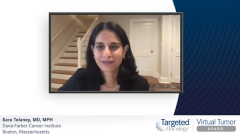
Case 3: Distant Metastases in Triple-Positive Breast Cancer
Episodes in this series

Ruta Rao, MD: Let’s move on in this patient’s case. She does well. She’s given her adjuvant hormonal therapy. Now 8 years later, she has distant disease develop in her liver, and this is also biopsy confirmed to be triple-positive metastatic breast cancer. Let’s talk about the metastatic setting: How do we incorporate antiestrogen therapy along with the HER2 [human epidermal growth factor receptor 2]–targeted therapies? Dr Jhaveri, do you want to start with how you would think about that?
Komal Jhaveri, MD, FACP: When we’re thinking about the first-line setting, we’re still thinking about how we manage these patients. Based on the overall survival benefit that we’ve seen with the CLEOPATRA trial regardless of the hormone receptor positivity, we think about first-line THP [taxane, trastuzumab, pertuzumab]–based regimens. This would be appropriate for this patient after 8 years. Because she has recurred, we can offer her that. Multiple efforts have been conducted, especially for this particular subgroup within the HER2-positive population, where we see cross talk between the endocrine and the HER2 pathways, and we see benefit for combining antiestrogen therapy with anti-HER2 therapy. We were talking about the early stage setting with the EXTENET clinical trial, where we saw that the benefit of adding neratinib was also in the hormone receptor–positive subgroup, which was based on this cross talk. We think that these patients benefit with such intervention. When we’re thinking about first-line setting, we can think about THP [taxane, trastuzumab, pertuzumab]. In the first-line setting, after induction therapy, there are trials such as the PATINA trial that show how, after completion of the induction chemotherapy and while getting your maintenance HP [trastuzumab, pertuzumab], patients can get endocrine therapy with or without CDK4/6 inhibitors added to that. That’s 1 thing we’ve tried to do in the first-line setting with these patients.
There are also data about patients who might not be appropriate for chemotherapy or for patients who don’t want to pursue chemotherapy for the adverse effects that they are concerned about, or if their disease burden is so minimal with oligometastatic disease with 1 or 2 bone lesions, for example. That would be an appropriate patient where one could potentially consider an alternative option to THP [taxane, trastuzumab, pertuzumab]–based therapy. We have safety data from the PERTAIN trial, which was a phase 2 trial looking at HP [trastuzumab, pertuzumab] with endocrine therapy, in that case AI [aromatase inhibitor], after induction chemotherapy, and that showed benefit. We also have the phase 3 ALTERNATIVE trial that looked at lapatinib in combination with AI and trastuzumab. The triplet, when compared with lapatinib plus AI, was superior, as dual-HER2 blockade with endocrine therapy, with the median PFS [progression-free survival] of about 11 months in that triplet. Then Dr Tolaney led the monarcHER study, and she can walk us through the monarcHER data with abemaciclib, fulvestrant, and trastuzumab.
Sara Tolaney, MD, MPH: The monarcHER trial was looking at patients who had progressed on 2 prior HER2-directed therapies for their metastatic HER2-positive disease. They were randomized to get fulvestrant with abemaciclib and trastuzumab, to get abemaciclib and trastuzumab, or to get chemotherapy and trastuzumab. It was a randomized phase 2 trial. The study demonstrated that the triplet combination, fulvestrant-abemaciclib-trastuzumab, was superior to chemotherapy and trastuzumab with an improvement in progression-free survival of around 2½ months of difference between the 2 arms. There was also a doubling in objective response rate favoring the abemaciclib arm compared with chemotherapy and trastuzumab. It’s an attractive idea to think that perhaps a nonchemotherapy option in this later-line setting could be an alternative for these ER [estrogen receptor]–positive HER2-positive patients.
We’ll see more to come with CDK4/6 inhibitors in this space. You alluded to the PATINA trial, which is looking at that first-line maintenance strategy. We will also have data from the ongoing PATRICIA trial, which is comparing endocrine therapy with CDK4/6 and trastuzumab to either chemotherapy-trastuzumab or T-DM1 [trastuzumab emtansine]. There will be more data about this because it would be an attractive nonchemotherapy option. It’s also a reminder that we tend to treat our metastatic HER2-positive patients along the same f paradigm of THP [taxane, trastuzumab, pertuzumab], T-DM1 [trastuzumab emtansine], and so on, but it’s important to incorporate endocrine therapy into these patients’ treatment regimens at some point, whether it’s in the maintenance up-front setting with HP [trastuzumab, pertuzumab] or even as you alluded to using dual anti-HER2 therapy with endocrine therapy without chemotherapy. It’s important to give it at some point, so we should not forget about it.
Ruta Rao, MD: Thank you for that nice summary of what we know so far about CDK4/6 inhibitors in this setting. To conclude this case, are there any other biomarkers you would think about in these triple-positive breast cancer cases, or are there any other targeted approaches that you know that are being looked at beyond CDK4/6 inhibition, Dr Tolaney?
Sara Tolaney, MD, MPH: With regard to CDK4/6 inhibitors, we saw some data from the initial PATRICIA trial that suggested that the luminal subtypes of the hormone receptor–positive, HER2-positive cancers were the ones that seemed to derive greatest benefit from CDK4/6 inhibition, making us wonder if intrinsic subtype could be a potential biomarker to help us select patients for CDK4/6 inhibition. Another area of interest has been PI3 kinase inhibitors, certainly for hormone receptor–positive, HER2-negative disease, and the use of alpelisib with endocrine therapy is now a standard option in the PIK3C-mutant population.
There is also interest in seeing if alpelisib could have a role in hormone receptor–positive/HER2–positive disease. There are a few studies ongoing. There’s 1 trial that is designed similarly to the PATINA idea; it is trying to look at alpelisib as a maintenance strategy with endocrine therapy after completion of the up-front chemotherapy phase. It will be interesting to see what the data look like with the kinase inhibitors in this setting as well.
Ruta Rao, MD: Thank you very much. With that, I would like to conclude, and I want to give a huge thank you to our panel for your thoughtful case presentations and your lively, informative discussion of all the things going on in the HER2-positive breast cancer setting. To our viewing audience, thank you for joining us for this Targeted Oncology™ Virtual Tumor Board® presentation. We hope the discussion was a valuable use of your time and that you acquired some practical knowledge that you can take back to the clinic.
Transcript edited for clarity.












































